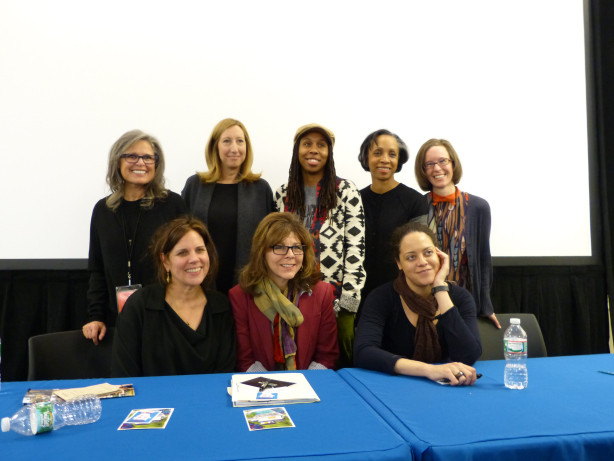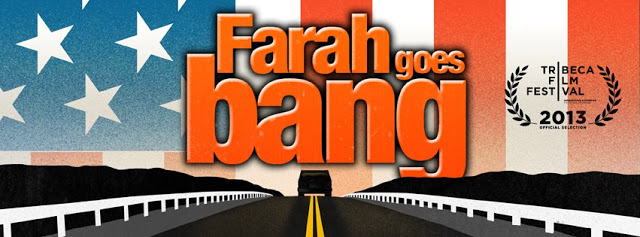
This is a guest post by Emily U. Hashimoto.
To reveal how films are created is to lose faith in a medium many of us love so much; perhaps like laws and sausage, it’s best not to see how it’s made. Yet for those of us interested in being a part of that process, the fascination lingers, and to this end I made my way to the Athena Film Festival last weekend, a three day celebration of women and leadership. The three day event featured films – including Frozen, Farah Goes Bang, In A World, and Maidentrip – as well as panels and workshops with seasoned professionals that are creating and helping to create strong portrayals of women.
My entry point to this area is my interest in creating media that highlights women of color, queer people, its intersection, and other types of characters not often seen on screen. People who aren’t lawyers or in advertising. People who wear the same sweater more than once. People who don’t fit into prefab boxes. My conviction about the need for more diverse content won’t ever falter, but hearing truths from women working in the field is, unfortunately, a downer. While representation of women remains a glaring issue, it’s in the creation of stories and characters where we continue to see problems. For example, during a panel with producers, an entertainment lawyer, and others, one woman who works in production said that when a film is in its initial stages and agents have the opportunity to suggest writers and directors, they won’t mention any women because they know the studio won’t go for it. When studio executives get asked why women’s names aren’t put forward, they say that agents won’t support those choices. What we have here is a classic catch-22 clusterfuck that’s hard to escape, without a suitable conclusion that puts more women to work.

This inclusion issue exists at all levels. Executives that are women or people of color aren’t willing to step forward to support a script about women or people of color, lest they be seen as ‘pushing an agenda.’ So even when there is more representation of studio executives, a balm you’d think is a panacea, the willingness to stick to the predetermined rules is more of a draw for the people who select this kind of work.
It kind of continues to be bad news.
The statistics don’t support a woman’s endeavor into film. San Diego State University’s Center for the Study of Women in Television and Film’s research tells us that in 2013, only 16% of all directors, executive producers, producers, writers, cinematographers, and editors involved in top grossing films were women. In television and independent film, women are better represented, with these figures being closer to 30%, but we’re still a long way from parity.

If one does make it through to the exclusive group of filmmakers, it doesn’t guarantee work. Nina Shaw, a leading entertainment lawyer, said during the panel that when studios are working on a project, they’ll have “The List” of possible directors and writers, a list that is often devoid of even one woman’s name. When she brings up women creators, the response is often, “Well, we talked about her…” She said, “it’s almost always a guy talking to a guy,” though as mentioned above, even having more women executives isn’t a boon to more women creators. The problem is bankability; women are not seen as people who can make a large-scale film because of the way we are perceived – never mind the fact that films with a woman lead are less expensive to make and end up making more money.
But the perception persists that women are not leaders enough to take the helm of a huge project. Directors (read: men) are supposed to be powerful, tough, and wise, and the way women are perceived clashes with that. When a woman director does sneak in the door and she displays the traits that a director should, there can be a terrible clash. Shaw described an anonymous situation of a woman director who had an adversarial relationship with her male producer on a film. She behaved as any director would, but that behavior made the producer bad mouth her all over town. She didn’t work steadily for years until she fell in with a successful female TV creator and showrunner.

Whether you work within the lines or not, as a woman creator you must be overwhelmingly prepared and talented. Lena Waithe, a queer woman of color that writes and produces, says that for women of color especially, there’s no room for mediocrity because you’re already seen as a risky entity. You have to work the hardest you’ve ever worked, while a male peer can, as Shaw described, get into a fight and be put in jail the night before a film starts shooting, halting production until he’s bailed out – and not get fired. If a female director pulled a stunt like that, she’d end up in “director jail,” a term for not being able to get work that Shaw said was very real.
Perception of women feeds into the writing process, too. Callie Khouri, writer of Thelma and Louise and creator of Nashville, said during her master class that before Thelma and Louise was made, the first question she’d get in a meeting was: “How are you going to change the ending?” Not “are you?” but “how?” – because what kind of movie ends with the female leads doing something as traditionally masculine as thinking the only way out is down? Khouri’s answer in these meetings was, “I’ll have the car drive faster over the cliff,” and her non-compromise formed what’s become a deeply iconic symbol of female friendship and rebellion. But it doesn’t change the fact that she was asked to make changes, a change that’s hard to envision someone asking of a male writer.
So. You’ve made your film, and Roger Ebert hates it and writes a really sexist review, which is the place Khouri found herself in after co-writing and directing The Divine Secrets of the Ya-Ya Sisterhood. Reviews from Ebert and others tanked the film at the box office, which wasn’t so surprising to Khouri because “women’s films are denigrated” by critics, many of whom are men. Khouri went further, insinuating that the criticism came from a less than objective place, because the film “wasn’t made for him.” This kind of frustration seems to be part and parcel of the job, but after years in Hollywood, Khouri is able to distinguish who does what. It’s someone’s job to be critical. “Our part of the gig,” she said, “is to say, well, fuck you. It got made.”
It certainly got made. Which feels like the perfect time to segue over to good advice and bright spots that came from panels and workshops at the festival:
Khouri said try – to write, to direct – then finish. It’s simple advice, but many people are nervous to try their hand at something they’ve never done. Waithe attested to this, too: she offered to produce a friend’s film without even knowing what a producer does. This kind of go-with-it attitude sparks against the more gender-enforced norm of wanting to master something before starting up, as founder of Jezebel.com Anna Holmes said is a trait she can’t easily discard. Even more specific than try and finish, Waithe said start with a question that your viewers will engage with; it’ll make your work much more interactive and innovative.
Where you’re working and who you know are integral to making moves in film. Khouri said you have to go to the ballpark to play ball, whether it’s Los Angeles or New York or wherever your particular form of creativity is taking place. Once there, spend time with people who know more than you. Learn from the wisdom that others can offer, and then be willing to play that role once you’ve been around the block. Once you’re in the space, you may have to start as an assistant, then work your way up; that seems to be the route for most of the women who spoke during the festival. There’s something refreshing about such meritocracy, even as it feels like a challenging path with no guarantee.

Having said that, you can always buck the system entirely. During the panel with women experts, there was a lot of discussion about Kickstarter, Indiegogo, and how independent filmmaking are the way to truly run the show. Putting your work and intentions out into the world ahead of an actual film being produced can be a great way to find your audience, involving them ahead of time, but it needs to be done well to stand out. Working with a producer who can help with marketing was one suggestion on how to make this work.
Once your content is in motion, deciding how it’s presented is another important step. The panel discussed Orange is the New Black and how Jenji Kohan created the show with its white female lead as the “trojan horse” to hook mass audiences, then tell stories of a diversity of women characters – older women, queer women, women who are well off, women living on the streets, trans women. Likewise, Shonda Rhimes created Grey’s Anatomy and Meredith Grey with a similar set up, both shows displaying the success in employing these kinds of tactics. This method clearly works, but Waithe said that she prefers to be more straightforward – that her characters are people of color, that they’re queer, and there’s nothing to hide. Creators need to make these decisions, to decide how they want to represent their work.
So much of the representation of women in film feels inorganic to our lived experiences. Waithe attributed that to the phenomenon of men writing female characters, which leads to men “telling stories that are foreign to them.” Indeed, it’s undeniable that a woman directed and/or written film can often be truer than, for example, the way Woody Allen writes women, but more than anything, the statistics tell us that we simply need more women writing and directing more stories. As Holmes put it, it’s “important to mainstream women’s voices,” which will serve the women pushing to get their work produced and seen, and the audiences of women and men who will benefit from more inclusion, onscreen and off.
For more on the Athena Film Festival, read this terrific interview with co-founders Kathryn Kolbert and Melissa Silverstein.
Emily U. Hashimoto is a writer interested in pop culture, feminism, sexuality, and its intersections. She’s currently working on a memoir about her women’s studies study abroad trip and a screenplay that she hopes will cement her as the queer Nora Ephron. You can find her at books-feminism-everythingelse or @emilyhash.




